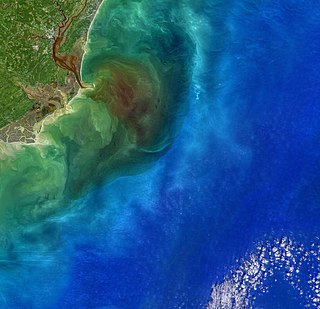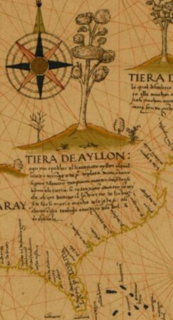
Juan Ponce de León was a Spanish explorer and conquistador known for leading the first official European expedition to Florida and for serving as the first governor of Puerto Rico. He was born in Santervás de Campos, Valladolid, Spain in 1474. Though little is known about his family, he was of noble birth and served in the Spanish military from a young age. He first came to the Americas as a "gentleman volunteer" with Christopher Columbus's second expedition in 1493.

The Fountain of Youth, a mythical spring, allegedly restores the youth of anyone who drinks or bathes in its waters. Tales of such a fountain have been recounted around the world for thousands of years, appearing in the writings of Herodotus, in the Alexander romance, and in the stories of Prester John. Stories of similar waters also featured prominently among the people of the Caribbean during the Age of Exploration ; they spoke of the restorative powers of the water in the mythical land of Bimini. Based on these many legends, explorers and adventurers looked for the elusive Fountain of Youth or some other remedy to aging, generally associated with magic waters. These waters might have been a river, a spring or any other water-source said to reverse the aging process and to cure sickness when swallowed or bathed in.

Slavery in the colonial history of the United States, from 1526 to 1776, developed from complex factors, and researchers have proposed several theories to explain the development of the institution of slavery and of the slave trade. Slavery strongly correlated with the European colonies' demand for labor, especially for the labor-intensive plantation economies of the sugar colonies in the Caribbean and South America, operated by Great Britain, France, Spain, Portugal and the Dutch Republic.

Conquistadors or conquistadores were the explorer-soldiers of the Spanish and Portuguese Empires of the 15th and 16th centuries. During the Age of Discovery, conquistadors sailed beyond Europe to the Americas, Oceania, Africa, and Asia, colonizing and opening trade routes. They brought much of the Americas under the dominion of Spain and Portugal.

Álvar Núñez Cabeza de Vaca was a Spanish explorer of the New World, and one of four survivors of the 1527 Narváez expedition. During eight years of traveling across what is now the US Southwest, he became a trader and faith healer to various Native American tribes before reconnecting with Spanish civilization in Mexico in 1536. After returning to Spain in 1537, he wrote an account, first published in 1542 as La relación y comentarios, which in later editions was retitled Naufragios y comentarios. Cabeza de Vaca is sometimes considered a proto-anthropologist for his detailed accounts of the many tribes of Native Americans that he encountered.

Lucas Vázquez de Ayllón was a Spanish magistrate and explorer who in 1526 established the short-lived San Miguel de Gualdape colony, one of the first European attempts at a settlement in what is now the United States. Ayllón's account of the region inspired a number of later attempts by the Spanish and French governments to colonize the southeastern United States.
Estevanico, also known as Esteban de Dorantes or Mustafa Azemmouri, was the first African to explore North America.
The Waccamaw people were an Indigenous people of the Southeastern Woodlands, who lived in villages along the Waccamaw and Pee Dee rivers in North and South Carolina in the 18th century.

The history of the colonial period of South Carolina focuses on the English colonization that created one of the original Thirteen Colonies. Major settlement began after 1651 as the northern half of the British colony of Carolina attracted frontiersmen from Pennsylvania and Virginia, while the southern parts were populated by wealthy English people who set up large plantations dependent on slave labor, for the cultivation of cotton, rice, and indigo.
The Winyaw were a Native American tribe living near Winyah Bay, Black River, and the lower course of the Pee Dee River in South Carolina. The Winyaw people disappeared as a distinct entity after 1720 and are thought to have merged with the Waccamaw.

Spanish Florida was the first major European land claim and attempted settlement in North America during the European Age of Discovery. La Florida formed part of the Captaincy General of Cuba, the Viceroyalty of New Spain, and the Spanish Empire during Spanish colonization of the Americas. While its boundaries were never clearly or formally defined, the territory was initially much larger than the present-day state of Florida, extending over much of what is now the southeastern United States, including all of present-day Florida plus portions of Georgia, Alabama, Mississippi, North Carolina, South Carolina, and Louisiana. Spain's claim to this vast area was based on several wide-ranging expeditions mounted during the 16th century. A number of missions, settlements, and small forts existed in the 16th and to a lesser extent in the 17th century; they were eventually abandoned due to pressure from the expanding English and French colonial settlements, the collapse of the native populations, and the general difficulty in becoming agriculturally or economically self-sufficient. By the 18th century, Spain's control over La Florida did not extend much beyond a handful of forts near St. Augustine, St. Marks, and Pensacola, all within the boundaries of present-day Florida.

Winyah Bay is a coastal estuary that is the confluence of the Waccamaw River, the Pee Dee River, the Black River, and the Sampit River in Georgetown County, in eastern South Carolina. Its name comes from the Winyaw, who used to inhabit the region during the eighteenth century. The historic port city of Georgetown is located on the bay, and the bay generally serves as the terminating point for the Grand Strand.

San Miguel de Gualdape is a former Spanish colony in present-day South Carolina, founded in 1526 by Lucas Vázquez de Ayllón. It was the first European settlement in what became the continental United States, and the third in North America north of Mexico.

Peter Martyr d'Anghiera, formerly known in English as Peter Martyr of Angleria, was an Italian historian at the service of Spain during the Age of Exploration. He wrote the first accounts of explorations in Central and South America in a series of letters and reports, grouped in the original Latin publications of 1511 to 1530 into sets of ten chapters called "decades." His Decades are of great value in the history of geography and discovery. His De Orbe Novo describes the first contacts of Europeans and Native Americans, Native American civilizations in the Caribbean and North America, as well as Mesoamerica, and includes, for example, the first European reference to India rubber. It was first translated into English in 1555, and in a fuller version in 1912.
Santa Elena, a Spanish settlement on what is now Parris Island, South Carolina, was the capital of Spanish Florida from 1566 to 1587. It was established under Pedro Menéndez de Avilés, the first governor of Spanish Florida. There had been a number of earlier attempts to establish colonies in the area by both the Spanish and the French, who had been inspired by the earlier accounts by Chicora and Hernando de Soto of rich territories in the interior. Menéndez's Santa Elena settlement was intended as the new capital of the Spanish colony of La Florida, shifting the focus of Spanish colonial efforts north from St. Augustine, which had been established in 1565 to oust the French from their colony of Fort Caroline. Santa Elena was ultimately built at the site of the abandoned French outpost of Charlesfort, founded in 1562 by Jean Ribault.

The Cusabo or Cosabo were a group of American Indian tribes who lived along the coast of the Atlantic Ocean in what is now South Carolina, approximately between present-day Charleston and south to the Savannah River, at the time of European colonization. English colonists often referred to them as one of the Settlement Indians of South Carolina, tribes who "settled" among the colonists.

Cofitachequi was a paramount chiefdom founded about 1300 AD and encountered by the Hernando de Soto expedition in South Carolina in April 1540. Cofitachequi was later visited by Juan Pardo during his two expeditions (1566–1568) and by Henry Woodward in 1670. Cofitachequi ceased to exist as a political entity prior to 1701.
Francisco de Chicora was the baptismal name given to a Native American kidnapped in 1521, along with 70 others, from near the mouth of the Pee Dee River by Spanish explorer Francisco Gordillo and slave trader Pedro de Quexos, based in Santo Domingo and the first Europeans to reach the area. From analysis of the account by Peter Martyr, court chronicler, the ethnographer John R. Swanton believed that Chicora was from a Catawban group.

Decades of the New World by Peter Martyr is a series of letters and reports of the early explorations of Central and South America that was published beginning 1511 and later anthologized. Being among the earliest such reports, Decades are of great value in the history of geography and discovery and describe the early contacts of Europeans and Native Americans derived from the narrative of the voyages of Christopher Columbus in the Caribbean and the reports from Hernán Cortés's Mexican expedition.

The White Lion was an English privateer operating under a Dutch letter of marque which brought the first Africans to the English colony of Virginia in 1619, a year before the arrival of the Mayflower in New England. Though the African captives were sold as indentured servants, the event is regarded as the start of slavery of Africans in colonial North America.
















